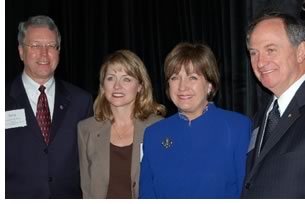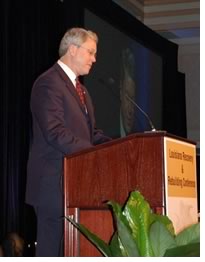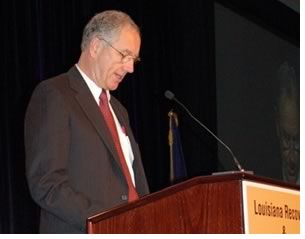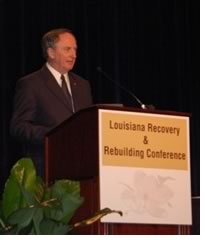

11/2005
 “Let
me thank you for holding this conference in New Orleans,” said
Louisiana Governor Kathleen Blanco to the participants at the Louisiana
Rebuilding and Recover Conference on the morning of November 10. “Never
before has a city of this size been evacuated, so many people been homeless,
or so many buildings been destroyed. However, never before has there
been such an opportunity to build in new ways while recreating our cultural
core.”
“Let
me thank you for holding this conference in New Orleans,” said
Louisiana Governor Kathleen Blanco to the participants at the Louisiana
Rebuilding and Recover Conference on the morning of November 10. “Never
before has a city of this size been evacuated, so many people been homeless,
or so many buildings been destroyed. However, never before has there
been such an opportunity to build in new ways while recreating our cultural
core.”
She said the region particularly welcomed the opportunity to rebuild to the standards of modern building codes and has asked the Louisiana legislature, currently in emergency session, to adopt its first-ever statewide building code. Other issues of eminent importance discussed by the governor were establishing community renewal zones, providing employment for local citizens, rebuilding wetlands, and revamping the state’s education system.
 “The experience and talents represented in this room are astonishing.
You are just the people we need—we are all turning to you to help
us rebuild,” the governor said.
“The experience and talents represented in this room are astonishing.
You are just the people we need—we are all turning to you to help
us rebuild,” the governor said.
Calling the conference a perfect combination of public and private collaboration, she concluded, “We are deeply grateful to the AIA, the American Planning Association, the National Trust for Historic Preservation, and the American Society of Civil Engineers, who have risen to the occasion to help us rebuild.”
Inspiring messages from New Orleans
In addition to the governor’s message, the first morning of the
Louisiana Recovery and Rebuilding Conference presented messages of hope
and expectation for the conference.
AIA Chief Operations Officer Jim Dinegar introduced Norman Robinson, the anchor of New Orleans’ WDSU, Channel 6. A native of New Orleans who brought eyewitness reports to his fellow citizens, Robinson thanked the AIA and other participating organizations for keeping this story alive.” He briefly told the audience of his experiences with the storm and the floods: “I was struck by the demonic effects of the flood waters. I have never seen water like this in 30 years of covering floods,” he said. Particularly symbolic of the destruction to him was his granddaughter’s crumbled upright piano. “It looked like bewitching exercise,” he said “If this story died, it would be another tragedy. You have our undying gratitude for your energy, and your dedication . . . Please be prolific—we need your ideas.”
 Collaborative process
Collaborative process
AIA Executive Vice President/CEO Norman L. Koonce, FAIA, told the group, “With
your presence and our collective commitment, we will define a path to
solutions that will lead to your designed paths,” he said. He explained
that the goal of the conference is to generate a body of defining principles. “Conceptual
ideas will be shared here. This will be a collaborative process engaging
everyone here.” Koonce assured the audience that the rebuilding
work cannot and will not be dictated by outside demands. “The visions
that we see will be your visions,” he said. “I wish you good
fortune from good planning.”
Driven by the citizens
AIA President Douglas L Steidl, FAIA, made clear that the role of the
AIA is not to dictate or advocate any solutions. “Our role is
to work with the citizens of this state and city,” he said. “The
participants will define what success looks like.” He reminded
the audience that Governor Blanco has called for all groups to work
together. The most important question we can ask, he concluded, is: “How
do we approach this disaster as an opportunity to create a better future?
Planning creates confidence
W. Paul Farmer, executive director and CEO of the American Planning Association
and a native of Shreveport, La., reminded the audience that, “We
know that together, we can accomplish much.” Recalling a brief
history of major city planning operations, he spoke of how Chicago
returned stronger than ever after the 1871 fire, and that after the
1989 Loma Prieta earthquake, San Francisco tore down a major freeway
that allowed its fabric of neighborhoods to be reunited. “Communities
can emerge more beautiful, more just, and more successful,” he
said. The process, of course, needs money, and “investments of
time, caring, and creativity” as the conference participants
have made clear. “We believe that planning is a way to create
confidence for a city,” he concluded, and confidence leads to
rebuilding and investor confidence.
 No discrimination
No discrimination
David Siegel, also of the American Planning Association, said that “most
of us can’t fathom the depth of feelings; only people who went
through it can.” He cautioned that “we cannot give up on
our cities, our rural communities, our people, and our culture.” He
noted that hurricanes Katrina and Rita did not discriminate in the misery
they wrought, and that “we cannot discriminate in our efforts to
replant and rebuild.” We need to engage community residence, give
citizens choices, and do planning right,” he concluded.
Preserving the culture
Xavier University President Dr. Norman Francis, who also chairs the Louisiana
Recovery Authority, said that he couldn’t imagine another group
with such expertise gathering in one place. “I thank you for
bringing our people hope,” he said. “At the Louisiana Recovery
Authority, we are volunteers—we know that we can’t do it
alone.” He says that the group hopes to work collaboratively
in the cities across Louisiana with the people of Louisiana to preserve
their culture and still make their cities better. “Katrina and
Rita did not discriminate—and now we are being brought together
to rebuild,” he told the audience. “We will be back—we
are determined to be back, and we will together welcome our people
back to a city that is bigger and better than the one we left.”
 Moving toward long-term recovery
Moving toward long-term recovery
Vice Admiral Thad Allen, chief of staff of the U.S. Coast Guard, who
currently is leading the federal recovery effort, explained how the
efforts he is directing are just now transitioning into long-term recovery.
The group currently is working on reestablishing the criminal justice
system, and on November 7 just began examining water resources. Admiral
Allen said that one of the main tasks for the federal groups is to
make sure that communications systems are in place to get critical
information across to citizens. “Your challenges are significant,” he
acknowledged. “We look forward to working with you, and wish
you good luck.”
People want to know they’re safe
On the morning of November 11, former Time managing editor, CNN director,
and New Orleans native Walter Isaacson joined David Downey, Assoc.
AIA, managing director of the AIA Center for Communities by Design
and a lead organizer of the conference, on CNN to explain the purpose
of the conference. One goal, Isaacson said, is to harden the city’s
levee system against a category-five hurricane. “We want to go
where we were supposed to be before Katrina,” he said of the
plan for the next five to six years. In the meantime, businesses and
families need “bridge” emergency loans and a clear statement
of intent to rebuild confidence, he said.
 People want to know they’re safe, even against a category-five
storm, Downey reiterated. The conference is just a beginning and an important
forum for the people of the city to speak out about flood control and
economic development. “The people are setting priorities and intent,” Downey
said.
People want to know they’re safe, even against a category-five
storm, Downey reiterated. The conference is just a beginning and an important
forum for the people of the city to speak out about flood control and
economic development. “The people are setting priorities and intent,” Downey
said.
Emphasizing the “no discrimination” message from the previous days’ proceedings, Isaacson stressed that the lower Ninth Ward of the city, one of the poorest parts of New Orleans and the most heavily damaged, is an integral part of the rich urban fabric that creates the city’s unique cultural heritage. The conference is giving all segments of the city a voice so that its rebuilding will bring the city back stronger and richer in spirit than before, he said.
Copyright 2005 The American Institute of Architects.
All rights reserved. Home Page ![]()
![]()
 |
||
From left, AIA President Douglas L Steidl, FAIA; AIA Louisiana President Trula Remson, AIA; Govornor Kathleen Blanco; and AIA Executive Vice President/CEO Norman L. Koonce, FAIA, at the November 10 planning conference in New Orleans. Photo by David Collins, FAIA. Read coverage of the conference in the New Orleans Times-Picayune. Also read the coverage in The Advocate.
|
||